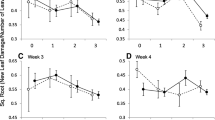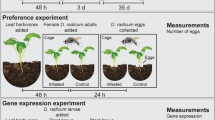Abstract
In this paper we demonstrate a UV-B-mediated link between host plants, herbivores and their parasitoids, using a model system consisting of a host plant Brassica oleracea, a herbivore Plutella xylostella and its parasitoid Cotesia plutellae. Ultraviolet-B radiation (UV-B) is a potent elicitor of a variety of changes in the chemistry, morphology and physiology of plants and animals. Recent studies have demonstrated that common signals, such as jasmonic acid (JA), play important roles in the mechanisms by which plants respond to UV-B and to damage by herbivores. Plant responses elicited by UV-B radiation can affect the choices of ovipositing female insects and the fitness of their offspring. This leads to the prediction that, in plants, the changes induced as a consequence of UV damage will be similar to those elicited in response to insect damage, including knock-on effects upon the next trophic level, predators. In our trials female P. xylostella oviposited preferentially on host plants grown in depleted UV-B conditions, while their larvae preferred to feed on tissues from UV-depleted regimes over those from UV-supplemented ones. Larval feeding patterns on UV-supplemented tissues met the predictions of models which propose that induced defences in plants should disperse herbivory; feeding scars were significantly smaller and more numerous – though not significantly so – than those on host plant leaves grown in UV-depleted conditions. Most importantly, female parasitoids also showed a clear pattern of preference when given the choice between host plants and attendant larvae from the different UV regimes; however, in the case of the female parasitoids, the choice was in favour of potential hosts foraging on UV-supplemented tissues. This study demonstrates the potential for UV-B to elicit a variety of interactions between trophic levels, most likely mediated through effects upon host plant chemistry.

Similar content being viewed by others
References
Agrawal AA, Kurashige NS (2003) A role for isothiocyanates in plant resistance against the specialist herbivore Pieris rapae. J Chem Ecol 29:1403–1415
Ballaré CL, Rousseaux MC, Searles PS, Zaller JG, Giordano CV, Robson TM, Caldwell MM, Sala OE, Scopel AL (2001) Impacts of solar ultraviolet-B radiation on terrestrial ecosystems of Tierra del Fuego (southern Argentina) – an overview of recent progress. J Photochem Photobiol B Biol 62:67–77
Bassman JH (2004) Ecosystem consequences of enhanced solar ultraviolet radiation: Secondary plant metabolites as mediators of multiple trophic interactions in terrestrial plant communities. Photochem Photobiol 79:382–398
Borell EM, Foggo A, Coleman RA (2004) Induced resistance in intertidal macroalgae modifies feeding behaviour of herbivorous snails. Oecologia 140:328–334
Caldwell MM (1971) Solar UV radiation and the growth and development of higher plants. In: Giese AC (ed) Photophysiology, vol. 6. Academic, New York, pp 131–171
Caldwell MM, Ballaré CL, Bornman JF, Flint SD, Bjorn LO, Teramura AH, Kulandaivelu G, Tevini M (2003) Terrestrial ecosystems increased solar ultraviolet radiation and interactions with other climatic change factors. Photochem Photobiol Sci 2:29–38
Caputo C, Rutitzky M, Ballaré CL (2006) Solar ultraviolet-B radiation alters the attractiveness of Arabidopsis plants to diamondback moths (Plutella xylostella L.): impacts on oviposition and involvement of the jasmonic acid pathway. Oecologia 149:81–90
Coleman RA, Barker AM, Fenner M (1997) A test of possible indirect mediation of wound-induced resistance in cabbage against Pieris brassicae. Oikos 80:43–50
Coleman RA, Barker AM, Fenner M (1999) Parasitism of the herbivore Pieris brassicae L. (Lep., Pieridae) by Cotesia glomerata L. (Hym., Braconidae) does not benefit the host plant by reduction of herbivory. J Appl Entomol 123:171–177
Dicke M (2000) Chemical ecology of host-plant selection by herbivorous arthropods: a multitrophic perspective. Biochem Syst Ecol 28:601–617
Dicke M, Hilker M (2003) Induced plant defences: from molecular biology to evolutionary ecology. Basic Appl Ecol 4:3–14
Edwards PJ, Wratten SD (1987) Ecological significance of wound-induced changes I plant chemistry. In: Labeyrie V, Farbes G, Lachaise D (eds) Insects–plants. Proc 6th Int Symp Insect–Plant Relationships. Junk, Dordrecht, pp 213–218
Edwards PJ, Wratten SD, Parker EA (1992) The ecological significance of rapid wound-induced changes in plants – insect grazing and plant competition. Oecologia 91:266–272
Gunn A (1998) The determination of larval phase coloration in the African armyworm Spodoptera exempta and its consequences for thermoregulation and protection from UV light. Entomol Exp Appl 86:125–133
Hatcher PE, Paul ND (1994) The effect of elevated UV-B radiation on herbivory of pea by Autographa gamma. Entomol Exp Appl 71:227–233
Holton MK, Lindroth RL, Nordheim EV (2003) Foliar quality influences tree–herbivore–parasitoid interactions: effects of elevated CO2, O-3, and plant genotype. Oecologia 137:233–244
Hunter MD (2003) Effects of plant quality on the population ecology of parasitoids. Agric For Entomol 5:1–8
Izaguirre MM, Scopel AL, Baldwin IT, Ballaré CL (2003) Convergent responses to stress. Solar ultraviolet-B radiation and Manduca sexta herbivory elicit overlapping transcriptional responses in field-grown plants of Nicotiana longiflora. Plant Physiol 132:1755–1767
Izaguirre MM, Mazza CA, Svatos A, Baldwin IT, Ballare CL (2007) Solar ultraviolet-B radiation and insect herbivory trigger partially overlapping phenolic responses in Nicotiana attenuata and Nicotiana longiflora. Ann Bot 99:103–109
Johnson KS (2005) Plant phenolics behave as radical scavengers in the context of insect (Manduca sexta) hemolymph and midgut fluid. J Agric Food Chem 53:10120–10126
Kosemura S (2002) Repellents against earthworms, hydroxamic acids and isothiocyanate from UV-B damaged maize and radish. Chem Lett 10:1010–1011
Lindroth RL, Hofmann RW, Campbell BD, McNabb WC, Hunt DY (2000) Population differences in Trifolium repens L-response to ultraviolet-B radiation: foliar chemistry and consequences for two lepidopteran herbivores. Oecologia 122:20–28
Lou YG, Du MH, Turlings TCJ, Cheng JA, Shan WF (2005) Exogenous application of jasmonic acid induces volatile emissions in rice and enhances parasitism of Nilaparvata lugens eggs by the parasitoid Anagrus nilaparvatae. J Chem Ecol 31:1985–2002
Mackerness SAH, Surplus SL, Blake P, John CF, Buchanan-Wollaston V, Jordan BR, Thomas B (1999) Ultraviolet-B-induced stress and changes in gene expression in Arabidopsis thaliana: role of signalling pathways controlled by jasmonic acid, ethylene and reactive oxygen species. Plant Cell Environ 22:1413–1423
Mazza CA, Boccalandro HE, Giordano CV, Battista D, Scopel AL, Ballare CL(2000) Functional significance and induction by solar radiation of ultraviolet-absorbing sunscreens in field-grown soybean crops. Plant Physiol 122:117–125
Mazza CA, Izaguirre MM, Zavala J, Scopel AL, Ballaré CL (2002) Insect perception of ambient ultraviolet-B radiation. Ecol Lett 5:722–726
McCloud ES, Berenbaum MR, Tuveson RW (1992) Furanocoumarin content and phototoxicity of rough lemon (Citrus jambhiri) foliage exposed to enhanced ultraviolet-B (UVB) irradiation. J Chem Ecol 18:1125–1137
Ojala K, Julkunen-Tiito R, Lindstrom L, Mappes J (2005) Diet affects the immune defence and life-history traits of an Arctiid moth Parasemia plantaginis. Evol Ecol Res 7:1153–1170
Parsons MA, Hadwiger LA (1998) Photoactivated psoralens elicit defense genes and phytoalexin production in the pea plant. Photochem Photobiol 67:438–445
Paul ND, Gwynn-Jones D (2003) Ecological roles of solar UV radiation: towards an integrated approach. Trends Ecol Evol 18:48–55
Paul ND, Rasanayagam S, Moody SA, Hatcher PE, Ayres PG (1997) The role of interactions between trophic levels in determining the effects of UV-B on terrestrial ecosystems. Plant Ecol 128:296–308
Polis GA, Strong DR (1996) Food web complexity and community dynamics. Am Nat 147:814–846
Roberts MR, Paul DN (2006) Seduced by the dark side: integrating molecular and ecological perspectives on the influence of light on plant defence against pests and pathogens. New Phytol 170:677–699
Roitberg BD, Boivin G, Vet LEM (2001) Fitness, parasitoids, and biological control: an opinion. Can Entomol 133:429–438
Rousseaux MC, Julkunen-Tiitto R, Searles PS, Scopel AL, Aphalo PJ, Ballare CL (2004) Solar UV-B radiation affects leaf quality and insect herbivory in the southern beech tree Nothofagus antarctica. Oecologia 138:505–512
Rozema J, Chardonnens A, Tosserams M, Hafkenscheid R, Bruijnzeel S (1997) Leaf thickness and UV-B absorbing pigments of plants in relation to an elevational gradient along the Blue Mountains, Jamaica. Plant Ecol 128:150–159
Sah NK, Taneja TK, Pathak N, Begum R, Athar M, Hasnain SE (1999) The baculovirus antiapoptotic p35 gene also functions via an oxidant-dependent pathway. Proc Natl Acad Sci USA 96:4838–4843
Schaller F (2001) Enzymes of the biosynthesis of octadecanoid-derived signalling molecules. J Exp Bot 52:11–23
Schoonhoven LM, Jermy T, van Loon JJA (1998) Insect–plant biology. Chapman and Hall, London
Schultz JC, Foster MA, Montgomery ME (1990) Host plant-mediated impacts of baculovirus on gypsy moth populations. In: Watt AD, Leather SR, Hunter AD, Kidd NAC (eds) Population dynamics of forest insects. Intercept, Andover
Searles PS, Flint SD, Caldwell MM (2001) A meta-analysis of plant field studies simulating stratospheric ozone depletion. Oecologia 127:1–10
Siemens DH, Mitchell-Olds T (1998) Evolution of pest-induced defenses in Brassica plants: tests of theory. Ecology 79:632–646
Soler R, Bezemer TM, Van der Putten WH, Vet LEM, Harvey JA (2005) Root herbivore effects on above-ground herbivore, parasitoid and hyperparasitoid performance via changes in plant quality. J Anim Ecol 74:1121–1130
Steinberg S, Dicke M, Vet LEM (1993) Relative importance of infochemicals from 1st and 2nd trophic level in long-range host location by the larval parasitoid Cotesia-glomerata. J Chem Ecol 19:47–59
Steinberg S, Dicke M, Vet LEM, Wanningen R (1992) Response of the braconid parasitoid Cotesia (= Apanteles) glomerata to volatile infochemicals – effects of bioassay set- up, parasitoid age and experience and barometric flux. Entomol Exp Appl 63:163–175
Tammaru T, Esperk T, Castellanos I (2002) No evidence for costs of being large in females of Orgyia spp. (Lepidoptera, Lymantriidae) larger is always better. Oecologia 133:430–438
Treutter D (2005) Significance of flavonoids in plant resistance and enhancement of their biosynthesis. Plant Biol 7:581–591
Vet LEM, Dicke M (1992) Ecology of infochemical use by natural enemies in a tritrophic context. Annu Rev Entomol 37:141–172
Vet LEM, Wackers FL, Dicke M (1991) How to hunt for hiding hosts – the reliability–detectability problem in foraging parasitoids. Neth J Zool 41:202–213
Wang XG, Messing RH (2004) Fitness consequences of body-size-dependent host species selection in a generalist ectoparasitoid. Behav Ecol Sociobiol 56:513–522
Wise MJ, Abrahamson WG (2007) Effects of resource availability on tolerance of herbivory: a review and assessment of three opposing models. Am Nat 169:443–454
Zavala JA, Scopel AL, Ballaré CL (2001) Effects of ambient UV-B radiation on soybean crops: impact on leaf herbivory by Anticarsia gemmatalis. Plant Ecol 156:121–130
Acknowledgements
We would like to thank the staff and students of the School of Biological Sciences of the University of Plymouth upon whose initial work this study was based. Our special thanks to Nigel Paul for discussion and helpful comments on draft versions, and to two anonymous referees and the handling editor, whose constructive criticisms were invaluable in improving the manuscript. We are grateful to P. Smithers, A. Watson and R. Ticehurst for technical assistance and support. The experiments performed for this study all confirm to the appropriate UK legal standards.
Author information
Authors and Affiliations
Corresponding author
Additional information
Communicated by Julia Koricheva.
Rights and permissions
About this article
Cite this article
Foggo, A., Higgins, S., Wargent, J.J. et al. Tri-trophic consequences of UV-B exposure: plants, herbivores and parasitoids. Oecologia 154, 505–512 (2007). https://doi.org/10.1007/s00442-007-0857-1
Received:
Accepted:
Published:
Issue Date:
DOI: https://doi.org/10.1007/s00442-007-0857-1




